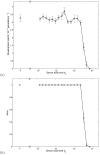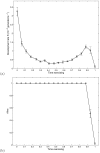Episodic, transient systemic acidosis delays evolution of the malignant phenotype: Possible mechanism for cancer prevention by increased physical activity
- PMID: 20406440
- PMCID: PMC2864239
- DOI: 10.1186/1745-6150-5-22
Episodic, transient systemic acidosis delays evolution of the malignant phenotype: Possible mechanism for cancer prevention by increased physical activity
Abstract
Background: The transition from premalignant to invasive tumour growth is a prolonged multistep process governed by phenotypic adaptation to changing microenvironmental selection pressures. Cancer prevention strategies are required to interrupt or delay somatic evolution of the malignant invasive phenotype. Empirical studies have consistently demonstrated that increased physical activity is highly effective in reducing the risk of breast cancer but the mechanism is unknown.
Results: Here we propose the hypothesis that exercise-induced transient systemic acidosis will alter the in situ tumour microenvironment and delay tumour adaptation to regional hypoxia and acidosis in the later stages of carcinogenesis. We test this hypothesis using a hybrid cellular automaton approach. This model has been previously applied to somatic evolution on epithelial surfaces and demonstrated three phases of somatic evolution, with cancer cells escaping in turn from the constraints of limited space, nutrient supply and waste removal. In this paper we extend the model to test our hypothesis that transient systemic acidosis is sufficient to arrest, or at least delay, transition from in situ to invasive cancer.
Conclusions: Model simulations demonstrate that repeated episodes of transient systemic acidosis will interrupt critical evolutionary steps in the later stages of carcinogenesis resulting in substantial delay in the evolution to the invasive phenotype. Our results suggest transient systemic acidosis may mediate the observed reduction in cancer risk associated with increased physical activity.
Figures



Similar articles
-
Metabolic changes during carcinogenesis: potential impact on invasiveness.J Theor Biol. 2007 Feb 21;244(4):703-13. doi: 10.1016/j.jtbi.2006.09.010. Epub 2006 Sep 16. J Theor Biol. 2007. PMID: 17055536
-
Adaptation to hypoxia and acidosis in carcinogenesis and tumor progression.Semin Cancer Biol. 2008 Oct;18(5):330-7. doi: 10.1016/j.semcancer.2008.03.011. Epub 2008 Mar 26. Semin Cancer Biol. 2008. PMID: 18455429 Free PMC article. Review.
-
Cellular adaptations to hypoxia and acidosis during somatic evolution of breast cancer.Br J Cancer. 2007 Sep 3;97(5):646-53. doi: 10.1038/sj.bjc.6603922. Epub 2007 Aug 7. Br J Cancer. 2007. PMID: 17687336 Free PMC article.
-
Systemic buffers inhibit carcinogenesis in TRAMP mice.J Urol. 2012 Aug;188(2):624-31. doi: 10.1016/j.juro.2012.03.113. Epub 2012 Jun 15. J Urol. 2012. PMID: 22704445 Free PMC article.
-
Why do cancers have high aerobic glycolysis?Nat Rev Cancer. 2004 Nov;4(11):891-9. doi: 10.1038/nrc1478. Nat Rev Cancer. 2004. PMID: 15516961 Review.
Cited by
-
Factors for the Primary Prevention of Breast Cancer: A Meta-Analysis of Prospective Cohort Studies.J Res Health Sci. 2021 Jul 20;21(3):e00520. doi: 10.34172/jrhs.2021.57. J Res Health Sci. 2021. PMID: 34698654 Free PMC article.
-
Cancer and Exercise: Warburg Hypothesis, Tumour Metabolism and High-Intensity Anaerobic Exercise.Sports (Basel). 2018 Jan 31;6(1):10. doi: 10.3390/sports6010010. Sports (Basel). 2018. PMID: 29910314 Free PMC article. Review.
-
On the Importance of Acidity in Cancer Cells and Therapy.Biology (Basel). 2024 Mar 29;13(4):225. doi: 10.3390/biology13040225. Biology (Basel). 2024. PMID: 38666837 Free PMC article. Review.
-
Impact of Physical Exercise on Melanoma Hallmarks: Current Status of Preclinical and Clinical Research.J Cancer. 2024 Jan 1;15(1):1-19. doi: 10.7150/jca.88559. eCollection 2024. J Cancer. 2024. PMID: 38164270 Free PMC article. Review.
-
Physical Activity as an Imperative Support in Breast Cancer Management.Cancers (Basel). 2020 Dec 28;13(1):55. doi: 10.3390/cancers13010055. Cancers (Basel). 2020. PMID: 33379177 Free PMC article. Review.
References
-
- Friedenreich CM, Orenstein MR. Physical activity and cancer prevention: etiologic evidence and biological mechanisms. J Nutr. 2002;132(11):3456S–3464S. - PubMed
-
- Suzuki S, Kojima M, Tokudome S, Mori M, Sakauchi F, Fujino Y, Wakai K, Lin Y, Kikuchi S, Tamakoshi K, Yatsuya H, Tamakoshi A. Effect of physical activity on breast cancer risk: findings of the Japan collaborative cohort study. Cancer Epidemiol Biomarkers Prev. 2008;17(12):3396–3401. doi: 10.1158/1055-9965.EPI-08-0497. - DOI - PubMed
-
- Cummings SR, Tice JA, Bauer S, Browner WS, Cuzick J, Ziv E, Vogel V, Shepherd J, Vachon C, Smith-Bindman R, Kerlikowske K. Prevention of breast cancer in postmenopausal women: approaches to estimating and reducing risk. J Natl Cancer Inst. 2009;101(6):384–398. doi: 10.1093/jnci/djp018. - DOI - PMC - PubMed
Publication types
MeSH terms
Grants and funding
LinkOut - more resources
Full Text Sources

